Collection Focus: Wayne University Illustrated Map, 1939 - Part 2
This is the second in a series of four blog posts annotating Jerry Peacock's 1939 cartoon map of the Wayne University campus. This entry discusses the block between Hancock Avenue and Warren Avenue, as well as the history of sororities at Wayne. View the entire map here or read Part 1.
10. Old Main, the flagship building of Wayne State University, was once the only high school in Detroit. It was built as Central High School (CHS) in 1896, replacing Capitol High School, which had burned down three years earlier. David Mackenzie became president of CHS in 1904, and his fortunes rose with the school's. CHS offered its first college-level course, a one-year pre-medical program, in 1913. In 1917 the Detroit Junior College (DJC) was established under the direction of Dean David Mackenzie. When the DJC merged with the Detroit Teachers College and the Detroit College of Medicine and Surgery in 1923 to form the College of the City of Detroit (CCD), Mackenzie remained dean and the CHS building -- still the home of Detroit's Central High School -- became headquarters of the newer, larger institution.
In 1925, the college fought to have a sign reading COLLEGE OF THE CITY OF DETROIT attached to the CHS building. There was resistance within the public school system, which was resolved in 1926 when the Central High School relocated north to Tuxedo Street to make room for the growing college. From this time on, the old CHS was called "the main building" and, eventually, "the old main building" as the campus expanded. It was officially renamed "Old Main" in 1950. The signs now carved into the building's stone still read WAYNE UNIVERSITY.
In 1939, the block where Old Main stood was the only sizable part of the central Wayne campus that the University actually owned. The area between Warren and Kirby avenues was purchased, block by block, between 1942 and 1945. At the time that this map was drawn, the University simply operated a number of houses as offices and classrooms, distributed across a residential area around what is now called Old Main.
11. Wayne has a long history of intramural and varsity sports. In 1939, the grounds of Old Main included tennis courts and a softball diamond. According to the 1923 Detroit Junior College yearbook, Wayne athletics began in 1917, when David Holmes left Cass Technical High School to become the coach of the DJC. Varsity basketball and football began that year, track began in 1918, tennis was introduced in 1921, and swimming, wrestling, and boxing were all introduced in 1922. The CCD athletic board chose an official nickname for its sports teams in 1927: "the Tartars." David Holmes served as the Director of Athletics for the DJC, the CCD, Wayne University, and Wayne State University, from which he retired in 1958. The Wayne State University Archives holds the records of the Health and Physical Education Division for the years 1940-1960.
The 1938-1939 Wayne tennis team had a perfect record of 24 wins and 0 losses in its intercollegiate matches. On the other hand, the football team lost six of its eight games that year, its worst season since 1932.
12. Wayne University's College of Engineering had a rocky start. In 1924 the City College of Detroit offered its first engineering degree program, and the first of these degrees was awarded in 1926. By 1934 the school offered courses and programs in the fields of aeronautical, chemical, civil, electrical, and mechanical engineering. The name of Wayne's engineering honor society, the Accemites, was taken from an acronym of those five specialties.
As class sizes increased, the engineering college's budget and facilities did not keep pace. The building labeled "Engineering" on Jerry Peacock's cartoon map, across Cass Avenue from Old Main, actually only housed some faculty offices. Labs and classrooms were located in increasingly crowded quarters in Old Main and the High School of Commerce. As a result of these cramped conditions, the school struggled to gain professional accreditation. The civil, electrical, and mechanical engineering programs were not accredited until 1944, and aeronautical and chemical engineering only received accreditation in 1950, allowing Wayne to finally offer graduate degrees in these fields. The first dedicated Engineering building opened in 1952.
13. The College of Medicine is represented on the map by a cheerful young student, walking south along Woodward, with a copy of Gray's Anatomy and a black bag of tools, including what looks like a saw.
The School of Medicine is the oldest component of Wayne University, and it has an appropriately complex history. It began with the Detroit Medical College, which was founded in 1868 and awarded its first M.D. degrees a year later. The Michigan College of Medicine opened in 1879, and competed with the Detroit Medical College until 1885, when the two schools merged to form the Detroit College of Medicine. In 1891 this institution gained departments of Veterinary Medicine, Pharmacy, and Dental Surgery; these departments were shuttered in 1899, 1905, and 1909, respectively. The Detroit College of Medicine was awarded "A" status by the American Medical Association in 1910, but lost that status three years later. In response, the school reorganized as the Detroit College of Medicine and Surgery, with changes in faculty and leadership. In 1918 the medical school was transferred to the control of the Detroit Board of Education, paving the way for its eventual inclusion in the Colleges of the City of Detroit in 1933.
At the time depicted in this map, the College of Medicine of Wayne University had 71 years of history. Annual tuition for resident students was $535. Medical students were largely independent of the rest of Wayne's population, with a campus far removed from Old Main and their own organizations and institutions, including six fraternities and one sorority.
14. David Mackenzie died in 1926, before CCD became Wayne University, but he did more to build a public university in Detroit than any other individual. The 1927 CCD yearbook opened with the following dedication:
If it is true that work ennobles, David Mackenzie was one of industry's finest noblemen, for his work in founding our great College of the City of Detroit marks an epoch in the progress of education and the development of Detroit's young manhood and womanhood. We who knew him well at "City" respected him as a scholar and valued him as a friend. It is our hope that the foward-looking principles and ideals of our late dean will ever be preserved in the policies of the college which he founded.
 In 1933 the Mackenzie Union, a social space for university students, was established in a rented house at the corner of Warren and Second Avenues and named in honor of David Mackenzie. The 1939 Handbook of Wayne University noted the amenities of the Mackenzie Union: a coffee bar, a darkroom for photographers, china and silver sets to be borrowed by other student organizations, dance records, and facilities for dances and winter sports.
In 1933 the Mackenzie Union, a social space for university students, was established in a rented house at the corner of Warren and Second Avenues and named in honor of David Mackenzie. The 1939 Handbook of Wayne University noted the amenities of the Mackenzie Union: a coffee bar, a darkroom for photographers, china and silver sets to be borrowed by other student organizations, dance records, and facilities for dances and winter sports.
David Mackenzie was also the namesake of the Mackenzie Honor Society (the men's honor society of Wayne), Mackenzie Hall (the renamed Webster Hall), and Mackenzie House (which still stands today and serves as the headquarters of Preservation Detroit). The Wayne State University Archives holds the papers of David Mackenzie.
15. The block of houses at the corner of Hancock Avenue and Second Boulevard includes a sorority and a fraternity, Alpha Delta Sigma and Chega. Each began as something other than a Greek letter organization, and each helped pave the way for Greek life at the university.
The 1943 Wayne University yearbook printed this origin for Alpha Theta Sigma:
In April, 1923, a group of women students at the Detroit Junior College organized the An-Tik-Lik Club, the second women's organization on the campus. This organization was not looked upon with approval. The dean, Mr. D. MacKenzie and the head of women's activities felt the organization was unnecessary and ruled against it since it might prove a forerunner of "sororities." However, they were prevailed upon to allow the group to show their worth with the understanding that failure meant losing their campus sponsorship. The members assisted organizations on campus, took an active part in college activities, distributed literary digest of the Collegian, collected $425.00 for the first push-ball for the Frosh-Soph games. As a result of outstanding service to the University, the club as a whole received recognition. In 1927, the group became a Greek letter social sorority.
An-Tik-Lik is pictured here in its 1924 yearbook photograph:
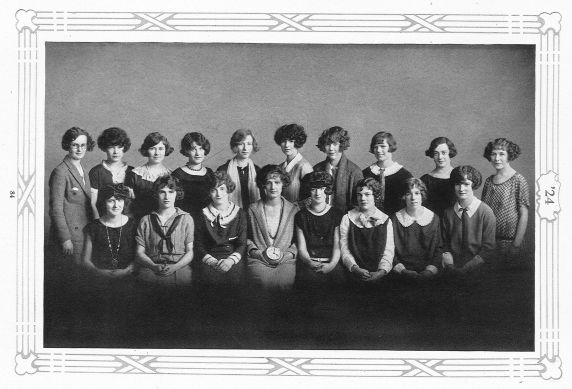
The Cheese Gang was established in the fall of 1922 as the freshmen disciplinary organization; it stood in opposition to the Gas House Gang, a club made up of sophomores, many of whom also held places on the football team. The two groups both, surprisingly, outlasted their origins: the Gas House Gang continued on as a club dedicated to the support of athletics and manly dress at Wayne, while the Cheese Gang, in 1923, became the fraternity Chega, which affiliated with the national fraternity Phi Sigma Epsilon in 1942. The Cheese Gang is shown here in its 1923 yearbook photograph:
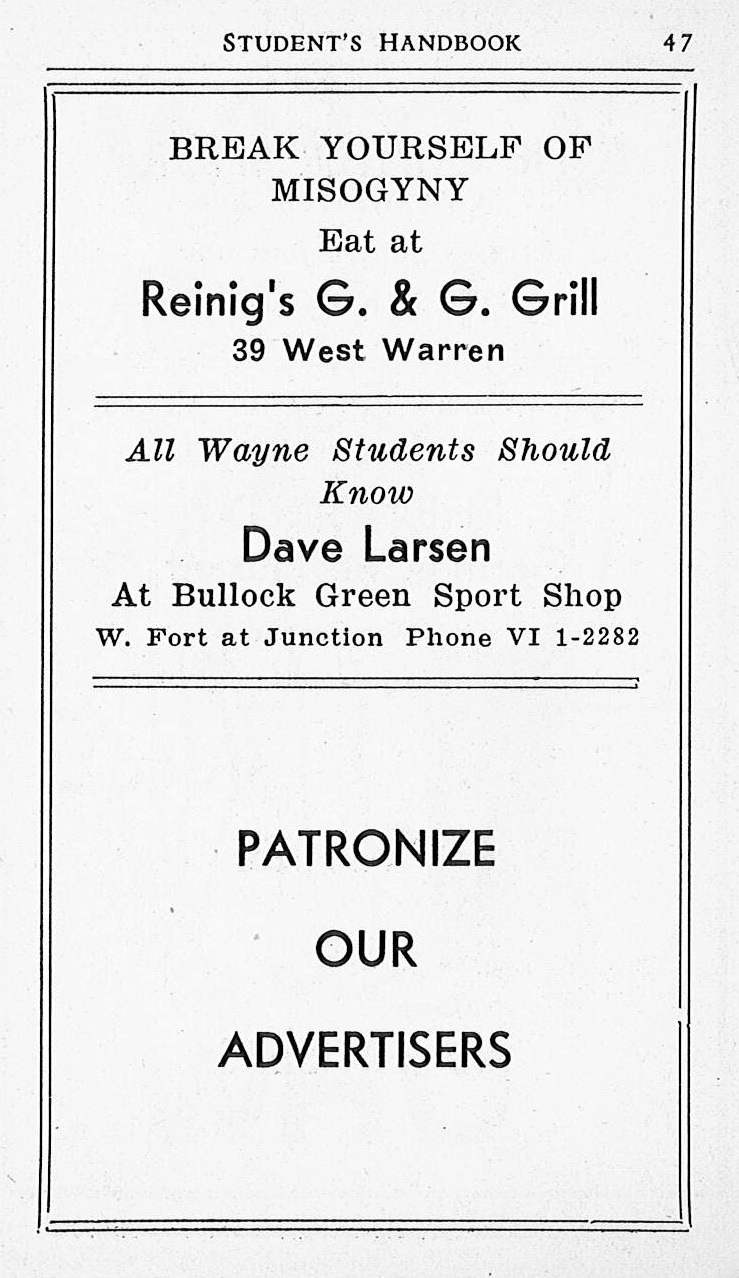
16. The strip of businesses on Warren between Cass and Woodward includes several frequent advertisers in the student publications of the late 1930s. Cass Warren Drug announced in a 1938 Detroit Collegian ad that it had been "Serving Wayne 14 Years" -- that is, it predated Wayne, and had been serving the College of the City of Detroit in 1924.
Reinig's Green and Gold Grill advertised itself as a meeting place for both male and female Wayne students. An ad in the 1939 Student Handbook encouraged (male) students to "BREAK YOURSELF OF MISOGYNY - Eat at Reinig's G. & G. Grill."
The Hunter Shop sold, among other things, stockings. The Main Library Cleaners and Hatters was a place where students could get their hats re-blocked. The Wayne Barber Shop and Waynette Beauty Salon advertised in the Student Handbook: "Beauty by the Waynette Beauty Salon enhances brains."
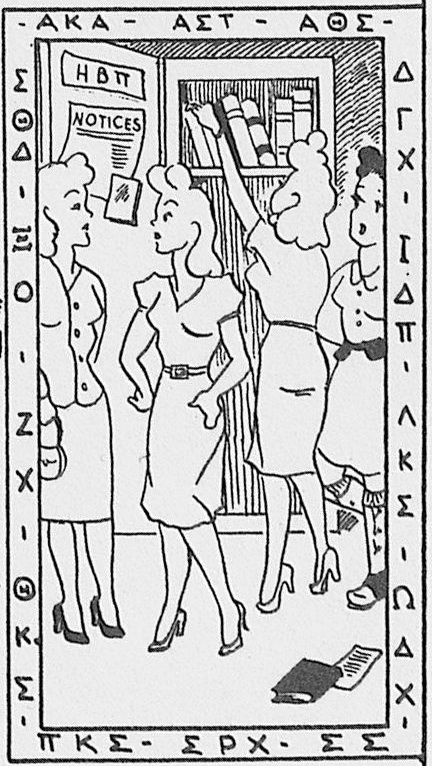
17. The inset to the right lists fourteen Wayne sororities: Alpha Kappa Alpha, Alpha Sigma Tau, Alpha Theta Sigma, Delta Gamma Chi, Iota Alpha Pi, Lambda Kappa Sigma, Omega Delta Chi, Pi Kappa Sigma, Sigma Rho Chi, Sigma Sigma, Sigma Theta Delta, Theta Kappa Sigma, Xi Omicron, and Zeta Chi. Four of these still exist today, two by different names. The fates of these fourteen organizations demonstrate some larger trends in twentieth-century college life.
The oldest of these sororities, founded in 1923, Alpha Sigma Tau was a professional sorority for education students. It ceased operations in 1986.
Alpha Theta Sigma (formerly An-Tik-Lik) was founded in 1924 and disbanded in 1953.
Delta Gamma Chi, founded 1926, became a chapter of the national sorority Kappa Delta in 1958. Wayne's Gamma Omicron chapter of Kappa Delta is still active.
Sigma Sigma, also founded in 1926, affiliated with the national sorority Alpha Gamma Delta in 1957. The Alpha Pi chapter of Alpha Gamma Delta is still active.
Sigma Theta Delta began as a local sorority, founded at Wayne in 1926. In 1953 it affiliated with the international historically Jewish sorority Phi Sigma Sigma as the Beta Sigma chapter. In 1970, this chapter detached itself from Phi Sigma Sigma to merge with Wayne's chapter of Delta Phi Epsilon, another international historically Jewish sorority; however, this move was short-lived, as the Delta Phi Epsilon chapter ceased to function in 1971.
Zeta Chi, the fourth of these groups founded in 1926, affiliated with the international Alpha Delta Pi sorority in 1957. It appears to have ceased to function in 1973.
Pi Kappa Sigma was a national sorority of education students which began at the Michigan State Normal School in 1894. A chapter was established at Wayne in 1928. In 1959, when the national organization was absorbed by the sorority Sigma Kappa, Wayne's chapter of Pi Kappa Sigma became the Delta Lambda chapter of Sigma Kappa. This group seems to have been inactive since 1970.
Lambda Kappa Sigma, an international fraternity of female pharmacy students and pharmacists, was established in 1913 and is now celebrating its first centennial. Wayne's chapter formed in 1930, and the Omnicron chapter is still active in the Eugene Applebaum College of Pharmacy and Health Sciences today.
Little information survives about Omega Delta Chi. This sorority was founded in 1930, but appears to have already been inactive by 1938.
The local sorority Sigma Rho Chi was founded at Wayne in 1934. In 1947 it became the Rho Chi chapter of the national sorority Alpha Sigma Alpha. The Wayne chapter disbanded in 1957.
Iota Alpha Pi was the first North American sorority established for Jewish women. Wayne's chapter joined the international organization in 1935. The local chapter became inactive in 1970, and the international sorority itself disbanded in 1971, due to a drastic decline in new pledges.
Xi Omicron, also founded in 1935, disbanded in 1951.
Alpha Kappa Alpha is the only social sorority listed here which has survived at Wayne from 1939 until the present without changing its name or merging with another organization. Alpha Kappa Alpha is the oldest historically black Greek-letter sorority in the United States, and Wayne's Beta Mu chapter has been active since 1936. This 1947 photo was the first appearance of Alpha Kappa Alpha in the Wayne University yearbook.
Little information about Theta Kappa Sigma has survived. This sorority existed by 1938 and disbanded by 1947.
The trend among all these groups, obviously, is towards affiliation with an external organization -- no local sorority has survived to 2013, except by becoming part of a larger body. Beyond that, however, there were two periods of crisis. Between 1947 and 1958, four of these sororities ceased to exist, and another five survived by becoming chapters of international organizations. Of those that remained, four disbanded between 1970 and 1973. The period after World War II, and the later years of the Vietnam War, exerted strong pressure on these social groups. This pattern will be apparent again in the fourth installment of this series, which will discuss the fates of nineteen fraternities at Wayne.
Next week's post will discuss the territory between Warren and Merrick Avenues. If you're interested in learning more about Wayne State's history, the best place to start is with Leslie Hanawalt's "A Place of Light," published in 1968. The University Archives are located in the Walter P. Reuther Library of Labor and Urban Affairs, and our Reading Room is open from 10 AM until 4 PM, Monday through Friday.
Alison Stankrauff is the Wayne State University Archivist.
| Attachment | (click to download) | |
|---|---|---|
| Student_Handbook_1939_p_47.jpg | 254.82 KB | |
| David_Mackenzie_1926.jpg | 287.39 KB | |
| Sorority_Detail.jpg | 167.23 KB |
- cwesterman's blog
- Login to post comments
- Printer-friendly version

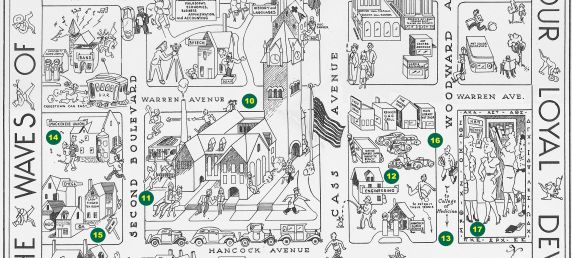
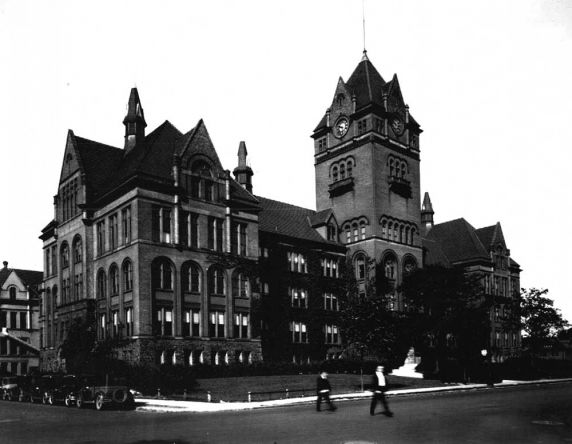
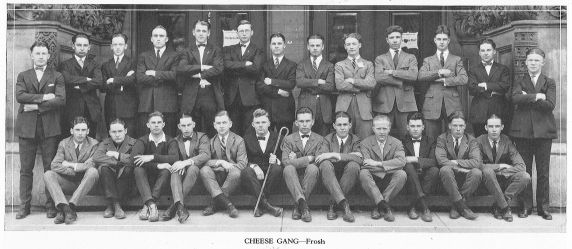
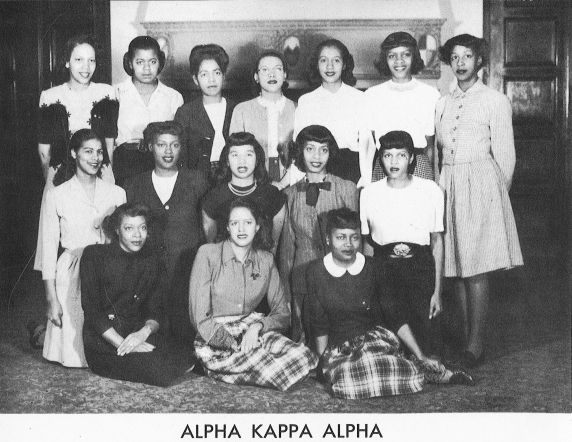
 Reddit
Reddit Facebook
Facebook LinkedIn
LinkedIn